Instagram is an image-heavy social media app that has been around for only seven years...but has left quite the impact in that short period of time.
In this article, we're going to explore the history, features, and business applications of Instagram. First, let’s set the scene with a quick, visual history of the app.
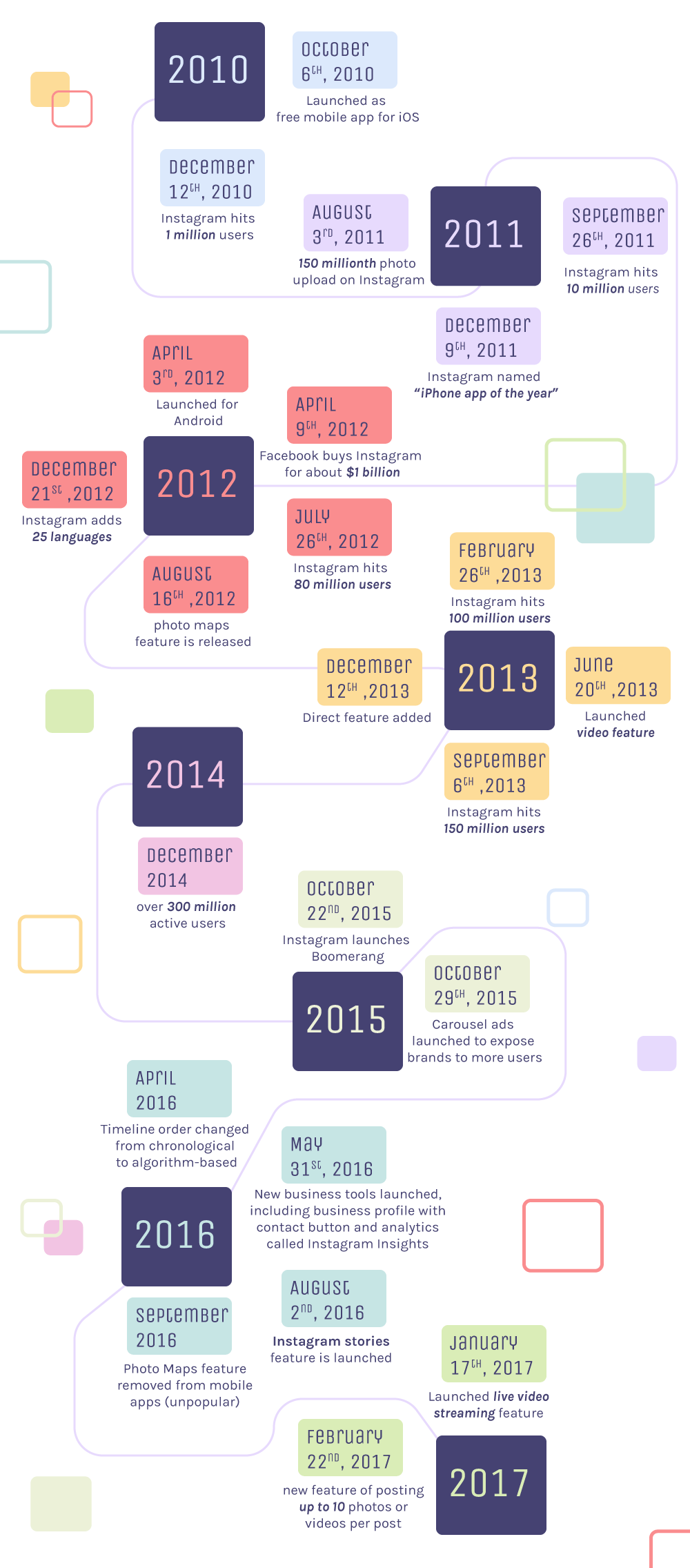
Background
The name Instagram comes from a marriage of two terms: instant camera and telegram. Created by Kevin Systrom and Mike Krieger in 2010, the point of the app is to have a quick and effective platform for sharing moments via photo or video while on-the-go or otherwise mobile.
It has about 600 million total daily active users and a grand total of around 40 billion photos shared to-date. The content on Instagram invokes 4.2 billion likes and 95 million photo uploads per day. That, my friend, is a lot of traffic in one place.
Instagram can be a good supplement to your online presence if your ideal customers already hang out there. Interestingly enough, 68% of Instagram users are female, and a whopping 80% of users—or 77.6 million people—are from outside the US. Leverage this statistic if you’re an international company to expand your reach to new markets.
If your marketing strategy is whittled down to just the most effective apps in terms of engagement, keep in mind that 20% of all internet users are on Instagram, so if your target market doesn’t line up well with Instagram user demographics, you may consider just skipping over the app.
Instagram is generally great for B2C brands, but B2B brands tend to have better luck with engaging their ideal customers on other platforms. If you're trying to get the best bang for your buck with a B2B brand, check out our ebook on successfully using Twitter, LinkedIn, Facebook, YouTube, and Google+ for driving traffic back to your brand's website.
Even if Instagram doesn't fit your audience or strategy now, make sure to reassess frequently so you don’t miss a later opportunity to leverage the amenities that Instagram offers—we’ll dive into those a little more later on.
So, which age groups love—and use—Instagram the most?
- 28% of people ages 18-29
- 4% of people ages 30-49
- Of 150 million users, 90% are under the age of 35
These statistics are easy to compare against your target audience to determine if Instagram is the right fit for your objectives—the bottom line is, if your ideal customer falls into the Insta-addict range, get on there!
If he or she definitely does not, save yourself the time and effort, then reassess at a future time. It’s all trial-and-error, however, so it doesn’t hurt to set up a free account if there is potential to buff up your online presence and increase your reach.
Besides, businesses are quickly jumping on the ‘gram train these days: 48.8% of brands have an account, and this number is expected to jump to a staggering 70% by the end of 2017.
Something to keep in mind with these numbers: if it becomes commonplace for most businesses to have an Instagram account, users may begin to expect to find their favorite brands on there—and may be disappointed if they don’t. This is one of those cases where jumping on the Instagram bandwagon may be more helpful than not.
Features
Though Instagram started as a simple platform with some basic functions—posting photos, following profiles, liking and commenting on photos—the app has increased functionality tenfold since launch.
I’ll walk you through all the important to features to familiarize yourself with in order to fully reap the benefits of using Instagram for business.
Insights
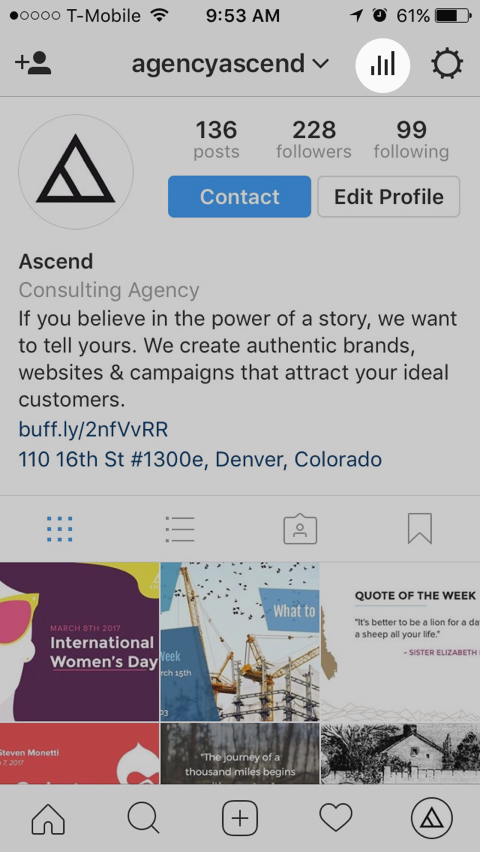
Since May 2016, Instagram got infinitely business-friendlier by adding a feature called Insights where you can measure impressions, reach, profile views, and number of clicks to your site.
Now measuring engagement on the platform is no longer a guessing game!
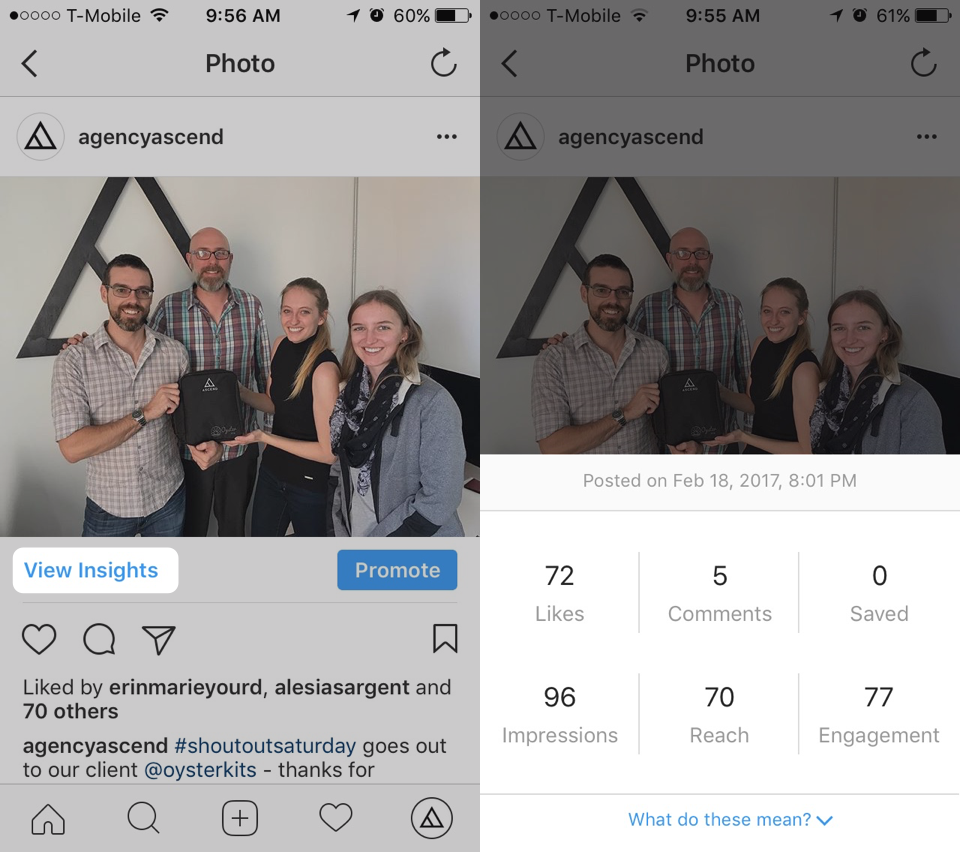
The way you can access Insights is by one of two ways: for overall engagement with your account, click on the little bar graph icon in the top right corner of your Instagram profile, or click on “view insights” underneath specific posts to see how those photos or videos performed.
Insights give you data on how many views your posts are getting, which performed best on different factors, and even follower demographics such as their active times on Instagram by day and week, gender, age, and location.
Putting together a buyer persona couldn’t be simpler!
Video
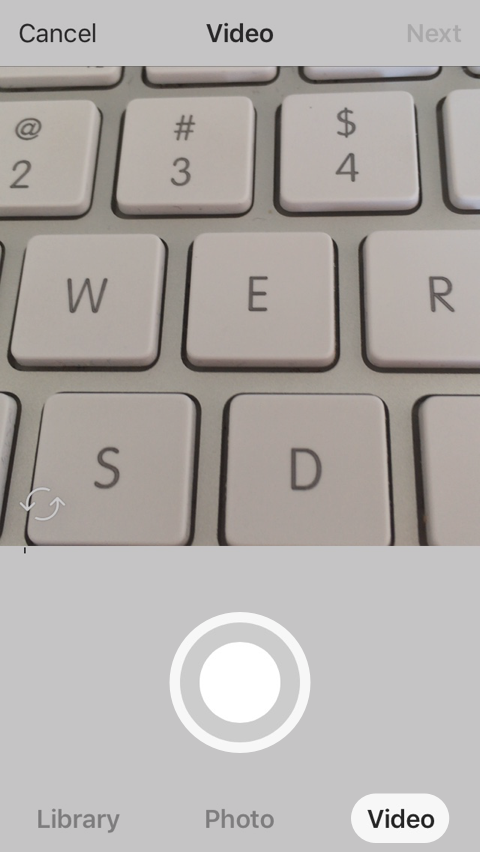
Though the app is known for photo sharing, Instagram has fully brought on a video element these days. At first, videos in posts were limited to only 60 seconds, but as of February 2017, users can now include—in one post, I might add—up to 10 minutes of video.
While the resolution is fixed at 640 by 640 pixels, widescreen video has been supported at 360p since late 2015. Videos statistically increase user engagement, so why not break up your image-only landscape with some movement to try it out?
To use this feature, tap the + sign on the bottom, tap “video” on the bottom right, then simply touch and hold the circle to record, lift your finger off to pause, and tap and hold again to record multiple clips in one.
Instagram Stories

Another cool video feature is that you can now, as of January 2017, go live—and if you find yourself thinking “but what does that mean?!”, get all caught up in our live video guide.
The feature, called Instagram Stories, seems like a hybrid creature, pulling elements from live video streaming platforms and Snapchat alike: videos cannot be saved or shared in lieu of Snapchat, and once the stream ends, the video simply disappears—forever.
All you have to do is start a live video, then watch as users tune in and leave comments. If your followers have post notifications for your profile turned on, they will be notified when you start a live video, which is helpful for ensuring a base level of engagement with your people that you can't otherwise get with regular posts.
You, as the live video host, have control: you can pin a comment to the top of the list or even disable comments altogether—good to have on deck for if your video’s comment section ever spins out of control.
To actually start a live video, tap the camera icon in the top left of the screen, then tap “live” at the bottom of the screen, and then select “start live video” from the options. When you’re done streaming, simply press “end” and confirm.
Instagram Stories is good for business: you, as the uploader, can save the live video and post it later—it’s a good way to recycle great content. Also, mentioning users who tune in or comment on your story is a good way to boost engagement while also showing that you care.
You can also curate your Instagram Stories into collections to feature on your profile—a great way to showcase your products or services as a brand.
Carousel
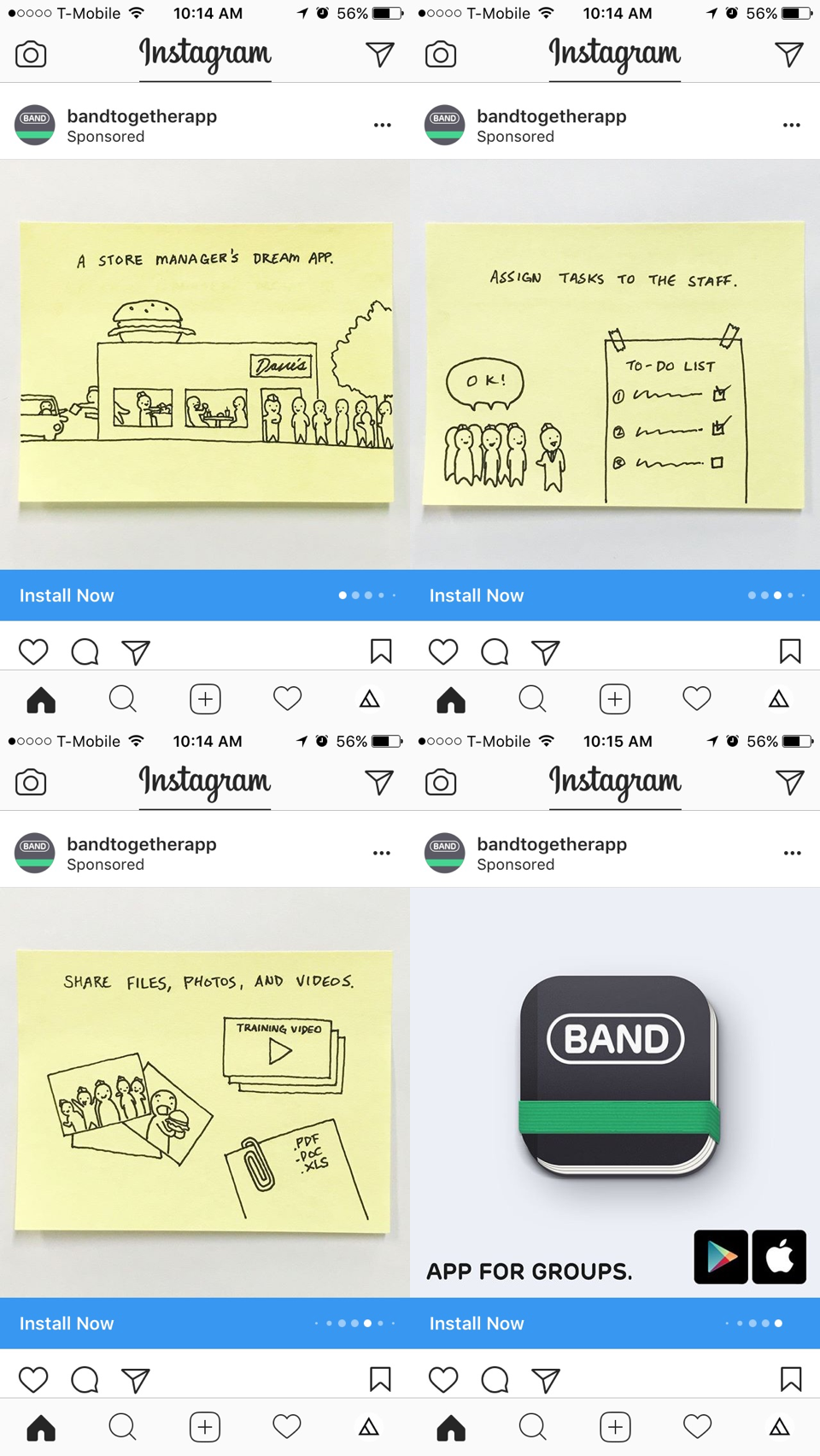
Carousel ads are an excellent method of marketing on Instagram: the multiple photo or video layout sparks interest and allows for showcasing more of your creativity. Arguably the most valuable factor is that you can add clickable links, unlike most anywhere else on the app.
While links were removed across the board due to spam and inappropriate use, much to the chagrin of marketers, creating carousel ads is a sort of loophole to this change, and a great way to direct users to your website—where all the magic happens anyway.
Shoppable Posts
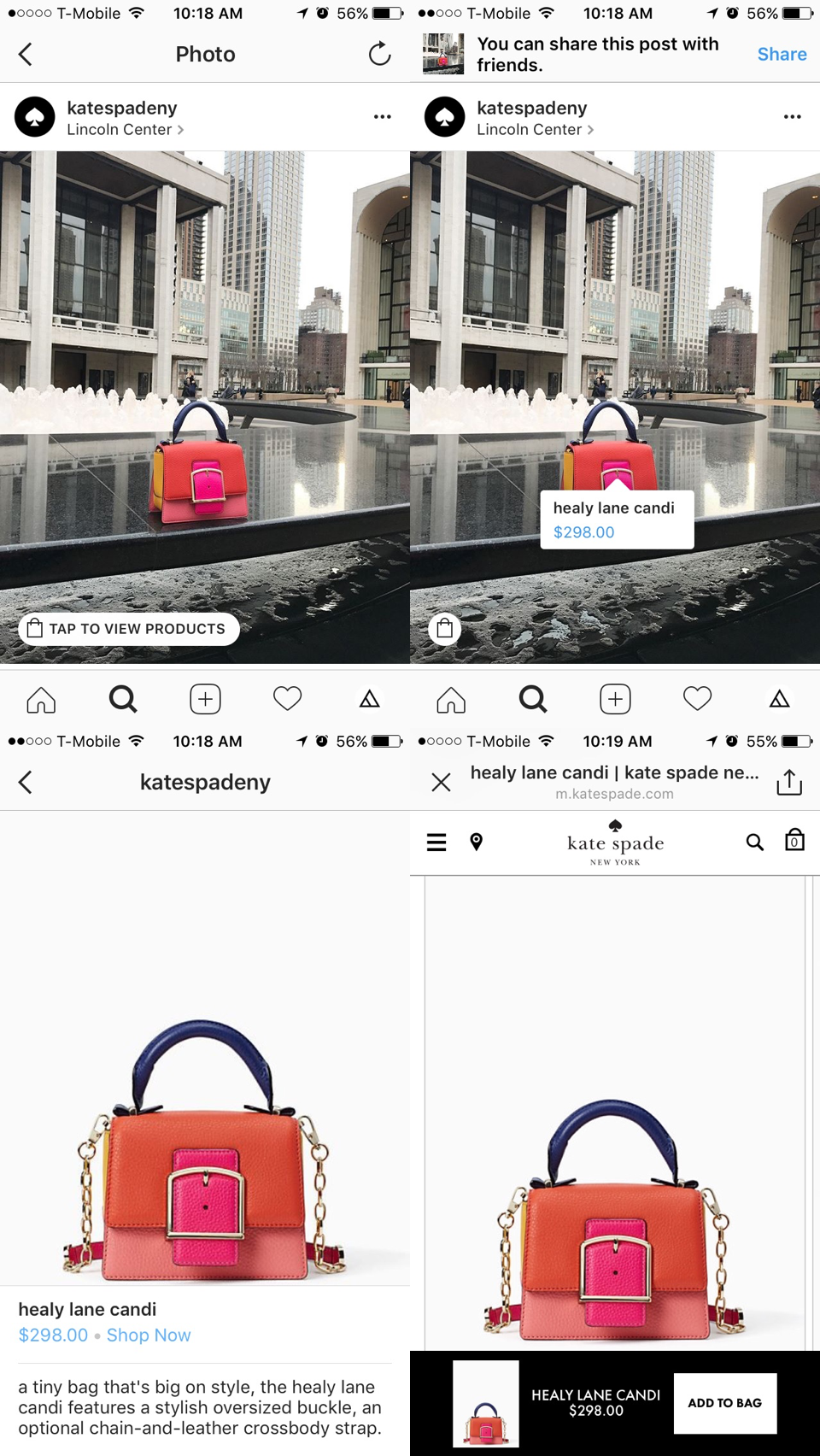
Instagrammers can now shop via posts—I don’t even have to mention the benefits of this feature for product-based businesses. The way it works on the users’ end is such: on the bottom left of the photo, users can click “tap to view” and image descriptions and product prices pop up on the screen, then the user can proceed by clicking the “shop now” link on the pop-up tag, which directs the user to the e-commerce site.
You can tag up to five products per post, so this feature is a perfect way for companies to showcase their products, ideally in an ensemble, in inspiring and emulative ways to potentially increase the overall sale value.
“Link in bio” Hack
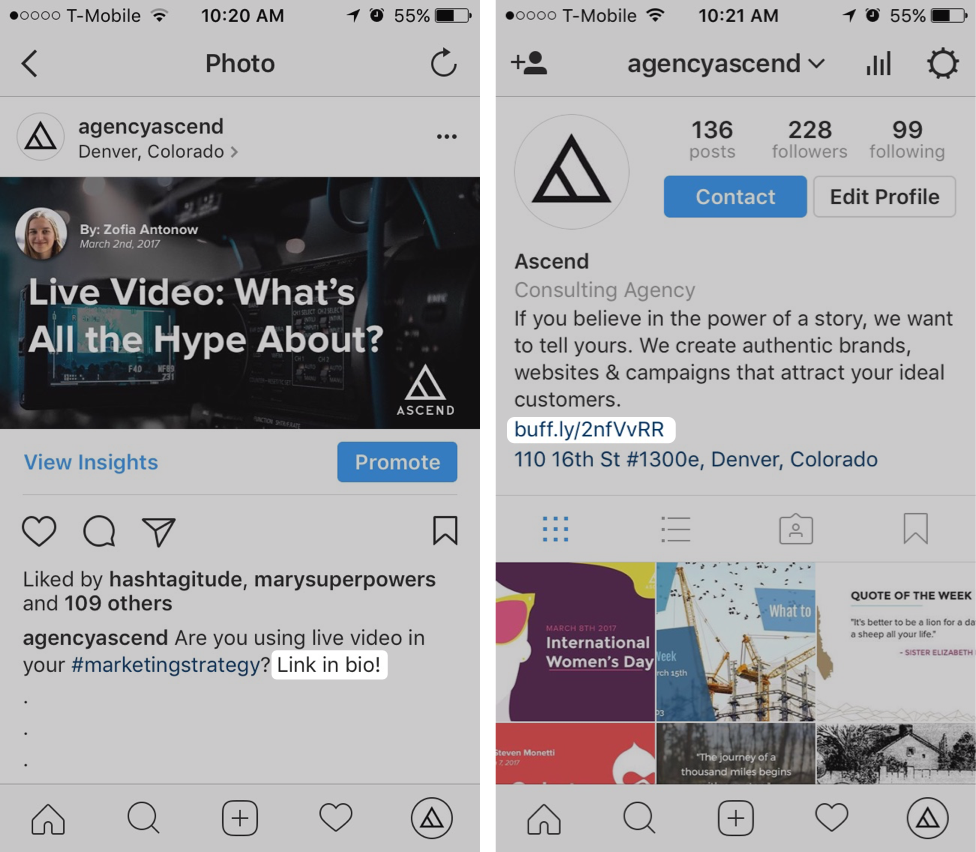
When you’re not an e-commerce site and don’t want to pay for carousel ads, there is one other possibility: simply use your bio. When you have a landing page you’d like to feature in a post, go to your profile, edit the bio section, paste the link in the designated section for links, then mention that the link is in your bio in the caption of the related post.
This is a good tactic for finding potential customers on Instagram and funneling them, quite literally, toward your site where the converting happens.
Just remember, if you’re going to use this method to include links, you must be cognizant of updating the link in the bio to match the most recent link-mentioning post on your profile so as to minimize confusion.
Home Feed Algorithm
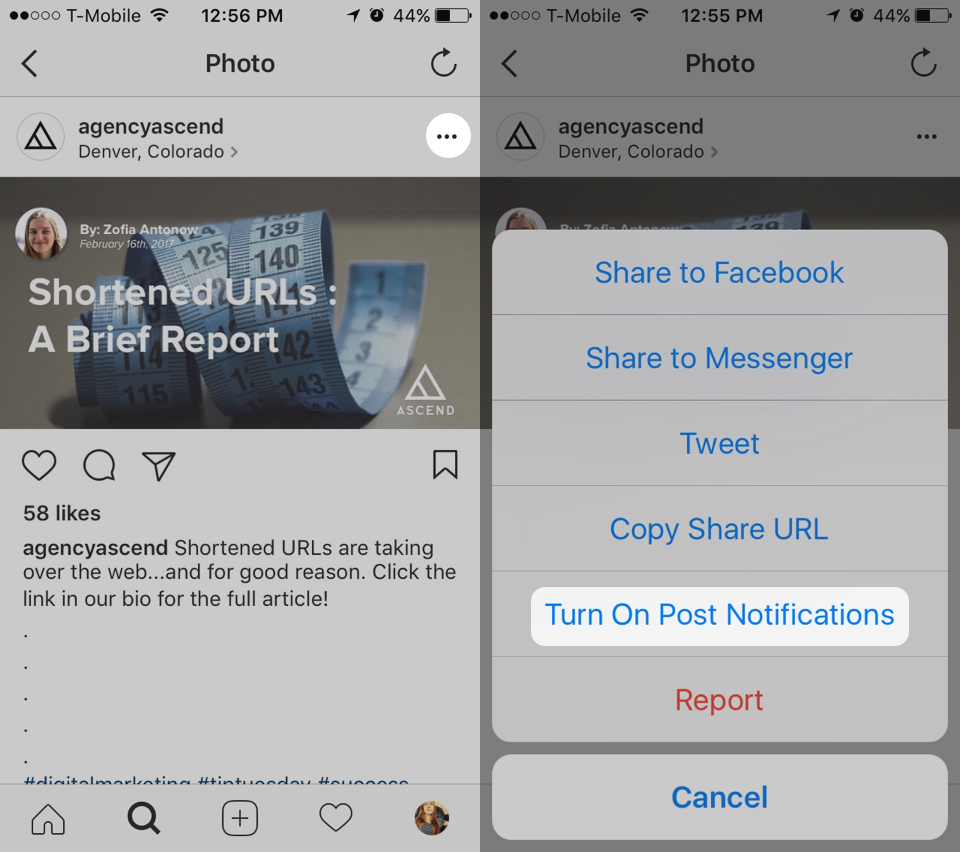
In April 2016, Instagram pulled a fast one on all of us and changed the order of the home section: while posts used to appear in chronological order on users’ feeds, the order is now determined by an algorithm.
The intent is to cater a user’s content more to their likes and preferences, but the big downside is that your content could get buried—or never get displayed in front of the right audience at all!
Lucky for you, there is a solution: ask your followers and fans to turn on post notifications for your profile.
The easiest way to do so is by creating a post about it where you explain how to click the three dots in the top right and click on “turn on post notifications” toward the bottom of the list. That’s all there is to it—and by doing so, you give your content a chance to get in front of more eyeballs than otherwise.
Save Posts
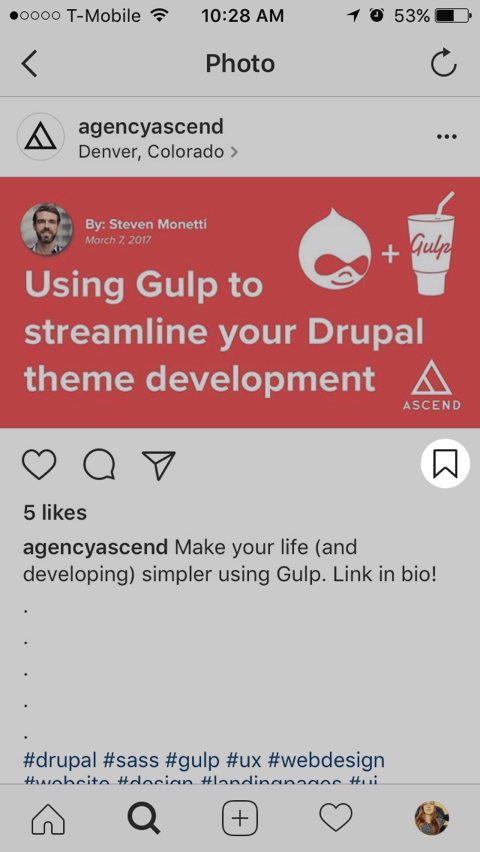
Instagram has a feature that allows any user to save any post. Simple enough, right?
The benefit here is that a user may save your brand’s post, which you will see on your end in the Insights feature, and this means that you are posting quality content—good enough to be put away for later.
This means that your brand will be in the consumers’ back of mind, which could come in handy when the person who saved your post considers your brand at the definitive point of the purchase funnel.
Zoom/Boomerang/Layout
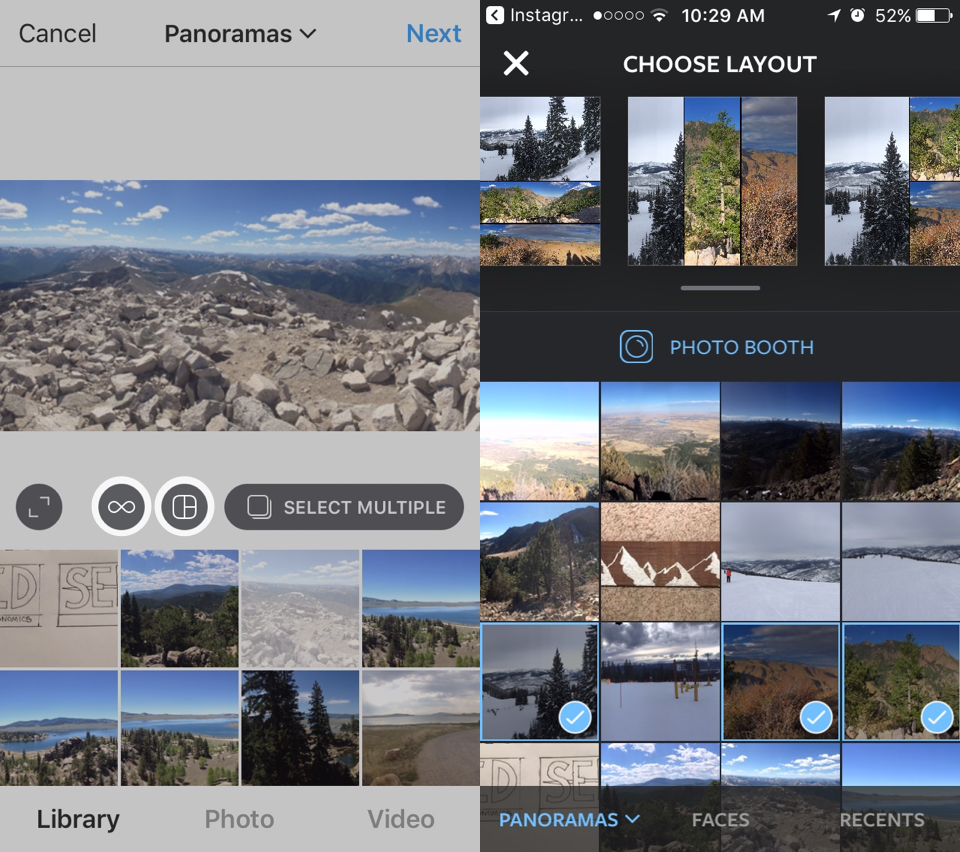
Until recently, there was no way of zooming in on an Instagram photo, which meant that content needed to be clear and visible from a small screen. Though the new zoom feature only works when the screen is being touched—and then resets when let go—it’s a nice feature to make the app more inclusive by accounting for those who are a little hard-of-seeing.
Content aesthetics are arguably most crucial on Instagram compared to other social media sites, so Instagram accommodates by including Boomerang and Layout extensions.
Boomerang is an app where you record a little, soundless video that then repeats in an infinite loop, much like a GIF. Because video has overall higher engagement rates online than photos do, Boomerang is a quick tool for adding some motion to your fans’ feeds.
Layout is an app that arranges multiple photos in a collage that can be easily posted to Instagram. There are plenty of collage-making apps, but the benefit here is that Layout is easy to use and less tacky than some competitors’ templates. Use these features to keep your content diverse and engaging!
Best Practices for Businesses
The first and most important item on your business-for-Instagram checklist is creating an official business account (and not just another user profile).
Let’s run through the setup first: when starting an account, make sure to select the business account option specifically. Your username should ideally be your company’s name, but if that’s already taken, opt for something that can be a unique brand identifier—the point is that your account represents your brand, loud and clear. Make sure to connect the account to your Facebook business account—if you launch any ads on Facebook, this allows you to also display those ads on Instagram without any separate setup.
Your bio is of the utmost importance: here you can link to your website or desired landing page, explain what it is exactly that you do, include other social links, and even throw in your slogan or tagline—if space (150 characters worth) allows.
The point of having the business profile format all lies in the contact button: users can click it to directly call or email your business, or get directions to your office. Neat-o!
Image Sizes
Make sure you get familiarized with the ideal image sizes for Instagram—this will ensure that your content displays clearly and correctly while maintaining great quality, no matter what.
What are the magic numbers, then?
- Your profile photo should be 180 x 180 pixels, but remember: it will appear as a perfect circle, so consider that when choosing an image.
- For posts, photos should always be 1080 pixels wide, but you get some flexibility with the image height: just keep it between 566 and 1350 pixels, alright?
- A good rule of thumb for photo posts is to keep the aspect ratio between 1.91:1 and 4:5.
Keeping these practices in mind when creating content for Instagram will help speed up (or ideally eliminate) the trial-and-error process and keep you on a roll of high-quality image posts.
#Hashtags
Hashtags, hashtags, hashtags! It’s virtually impossible to live in today’s world without knowledge of this term; it’s everywhere—and for good reason.
Hashtags provide a way for users to concisely caption their post, get their content out there and connect with like-minded people...sounds like the very reason you’re on social media, am I right? Besides, posts containing more than one hashtag have, on average, about 12.6% more engagement than those with fewer hashtags.
Use these handy little terms to your advantage: compile a list of hashtags that align with your business, related topics, content you post, etc., and have it ready for when it’s time to post. Also look up themed hashtags—that is, find hashtags that apply to different days of the week, big ones in your industry, or even holiday ones, such as #MLKDay.
Be wary of overly popular hashtags, however: there are over 335 million posts tagged with #tbt (Throwback Thursday), so if you were to post using this hashtag, your post would be smothered by tons of others and ultimately get drowned out.
My recommendation is to find hashtags that have over 10,000 existing posts but under 3 million, if possible. You don’t want to use an obscure hashtag with only a few posts because the point is to reach a significantly-sized audience.
Captions
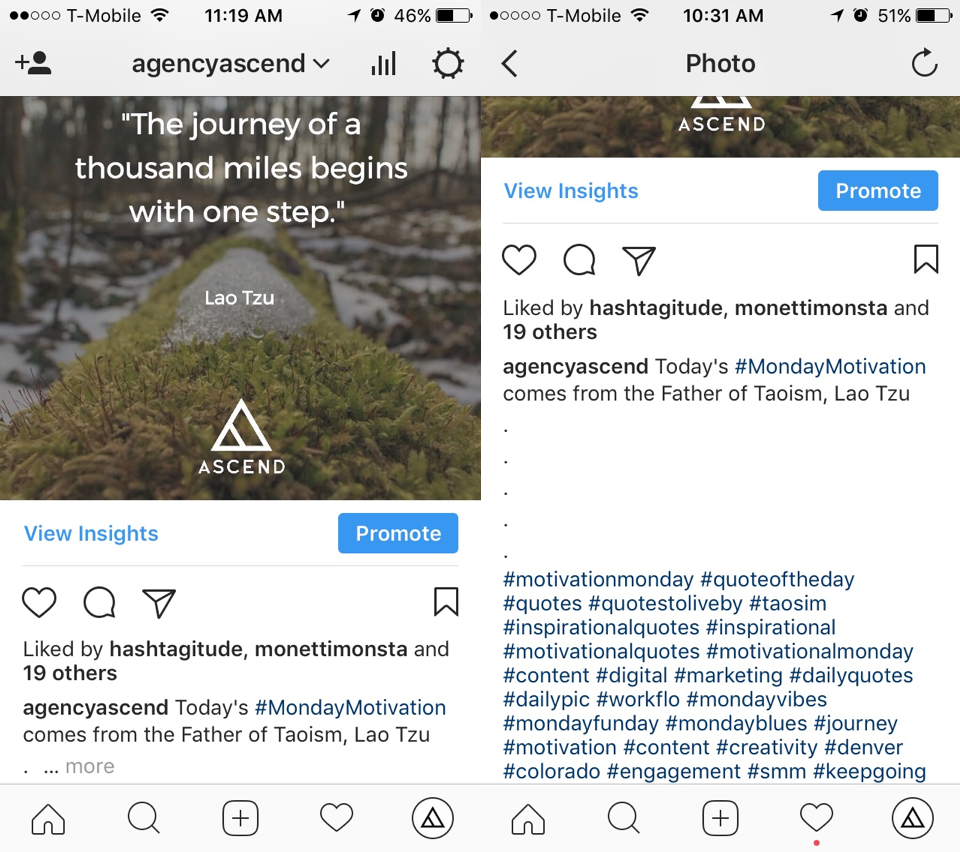
Post captions can be carefully curated to have just the caption visible with many relevant hashtags hidden underneath.
Here’s how you do it: make sure your caption, if using one, is right around 65 characters long. Then, and it’s important that you do this exactly, hit enter, add a period with no space after it, then repeat hitting enter and adding a period (no space!) for a total of five such rows.
Then add your hashtags, with spaces, until you have as many as you’d like—though the maximum allowed is 30 hashtags per post, so don’t go too crazy.
Users have developed a sixth sense for spam, so don’t give them the occasion to discount your brand as inauthentic.
Authenticity
Finally, most importantly, and per usual, be yourself! Users have developed a sixth sense for spam, so don’t give them the occasion to discount your brand as inauthentic.
Craft captions using your brand’s unique and consistent voice, post about things that are interesting to your followers, and measure engagement as you go to avoid drifting into the dreaded irrelevant zone. Instagram is designed so that followers are free to choose who they see in their feed, so capture your unique identifying factors through quality content to ensure that you make the cut!
Perhaps even more importantly, being authentic and practicing the techniques of inbound marketing will ensure that you properly follow Instagram's usage guidelines and keep your account out of "trouble."
There have been bouts of Instagram engagement drops from a whole host of users over the past year, so remember not to use the platform for blatant selling and always test your hashtags by searching for their results before associating your content with "banned" ones. The point is to have a place to connect with your real, live fans, so think of your account as a networking opportunity rather than an advertisement.
The Bottom Line
Instagram is a fun and hip platform to add to your marketing arsenal—it's a chance to show your brand's creative, spontaneous, or even creatively spontaneous side.
If you follow the rules, keep it interesting and authentic, and reach the right people, it can be quite the powerful tool for connecting with your ideal audience.
If you have any questions, comments, or Instagram success stories, please share below!




